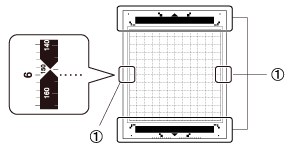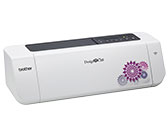DC200ULE
FAQs & Troubleshooting |
Mat and Material Combinations
The recommended material thickness is 0.1 mm to 0.3 mm for paper and 0.2 mm to 1.5 mm for fabric.
Refer to the following table for the appropriate mat and sheet for fabric cutting according to the material to be used for cutting or drawing.
-
Depending on the machine model, some accessories listed in the chart may not be included.
In that case, they must be purchased separately. - This chart is only a guide, always test material and mat strength prior to beginning project.
-
The settings indicated in the table are approximations. The setting will differ depending on the type and the
thickness of the material to be cut. Be sure to perform a trial cutting first.
| Material: | |
| Paper | |
| Fabric | |
| Others | |
Paper
| Material and its thickness | Mat | Type of Cutting blade |
Blade scale setting |
Cut pressure setting |
||
| Standard mat | Low tack adhesive mat | |||||
| Printer paper | 80 g/m² (0.1 mm) |
Standard cut blade (turquoise) |
3 | -1 | ||
| Scrapbook paper (thin) | 120 g/m² (0.15 mm) |
3.5 | 0 | |||
| Scrapbook paper (medium-thick) |
200 g/m² (0.25 mm) |
4 | 0 | |||
| Cardstock (thin) | 200 g/m² (0.25 mm) |
4 | 0 | |||
| Cardstock (medium-thick) |
280 g/m² (0.35 mm) |
5 | 0 | |||
| Vellum, tracing paper | 0.07 mm | 3 | 0 | |||
| Poster board (thin) | 280 g/m² (0.35 mm) |
5.5 | 0 | |||
| Poster board (thick) | 400 g/m² (0.5 mm) |
7.5 | 4 | |||
*1 When cutting smooth paper
Fabric *2
| Material and its thickness | Mat | Type of Cutting blade |
Blade scale setting |
Cut pressure setting |
||
| Standard mat | Low tack adhesive mat | |||||
| Thin cotton fabric (for quilt piece) |
0.25 mm | Standard cut blade (turquoise) |
4 | 4 | ||
| Thin cotton fabric (except for quilt piece) |
0.25 mm | 4 | 4 | |||
| Flannel (for quilt piece) | 0.6 mm | 6.5 | 4 | |||
| Flannel (except for quilt piece) |
0.6 mm | 6.5 | 4 | |||
| Felt | 1 mm | Deep cut blade (purple) |
5 | 5 | ||
| Denim 14 oz | 0.75 mm | 5.5 | 6 | |||
*2 When cutting fabric, use the sheet for fabric catting. Refer to Sheet for fabric cutting.
Others
| Material and its thickness | Mat | Type of Cutting blade |
Blade scale setting |
Cut pressure setting |
||
| Standard mat | Low tack adhesive mat | |||||
| Plastic sheet (PP) | 0.2 mm |
Standard cut blade
|
4 | 0 | ||
| Vinyl | 0.2 mm | 4 | 0 | |||
| Adhesive Craft Vinyl (backing sheet : 0.1 mm) | 0.07 mm | 1.5 *3 | -1 | |||
| Magnet | 0.3 mm | 5.5 | 0 | |||
| Sticker or seal | 0.2 mm | 4 | 0 | |||
| Sticker Sheet (backing sheet : 0.15 mm) |
0.15 mm | 2 *3 | -1 | |||
*3 Half cut
Mat
|
Standard mat |
High adhesive strength mat; use with cutting fabric. * Use the low tack adhesive mat with copy paper and smooth paper. Since the standard mat has a high adhesive strength, materials may remain stuck to the mat, causing the mat to become unusable. |
|
Low tack adhesive mat |
This is a mat with a low adhesive strength. It is suitable for copy paper and smooth paper. |
Sheet for fabric cutting
Use one of the following two sheets for fabric cutting when cutting fabric.
|
Iron-on fabric appliqué contact sheet (white backing) |
||
| For instructions on how to use the iron-on fabric appliqué contact sheet, refer to Cut the fabric Other than quilt pieces. (How to use the Iron-On Fabric Appliqué Contact Sheet.) | ||
|
- Thin cotton fabric (except for quilt piece) - Flannel (except for quilt piece) - Felt - Denim 14 oz |
|
|
|
High tack adhesive fabric support sheet |
||
| For instructions on how to use the high tack adhesive fabric support sheet, refer to Cut a thin fabric for the quilt piece. (How to use the High Tack Adhesive Fabric Support Sheet.) | ||
|
- Thin cotton fabric (for quilt piece) - Flannel (for quilt piece) |
|
|
-
Avoid using materials covered with a decorative layer that can easily peel off, such as lamé or foil.
Otherwise, the peeled-off layer may attach to rollers or sensors during operation, resulting in damage to the machine or to the cutting blade. -
Do not affix masking tape, etc., over the scanning marks. Otherwise, the mat may not be correctly recognized or
images may not be correctly scanned.

(1) Scanning marks - Adhere only 1 layer of material to the mat.
- Optional accessories available for your machine differ depending on the country.
- When using a 12" × 12" (305 mm × 305 mm) mat, the maximum work area for cutting/drawing is 296 mm × 298 mm (11 3/4" × 11 3/4").
- When using an optional 12" × 24" (305 mm × 610 mm) mat, the maximum work area for cutting/drawing is 296 mm × 603 mm (11 3/4" × 23 3/4").
- Some fabrics with uneven surfaces can be cut if turned upside down.
